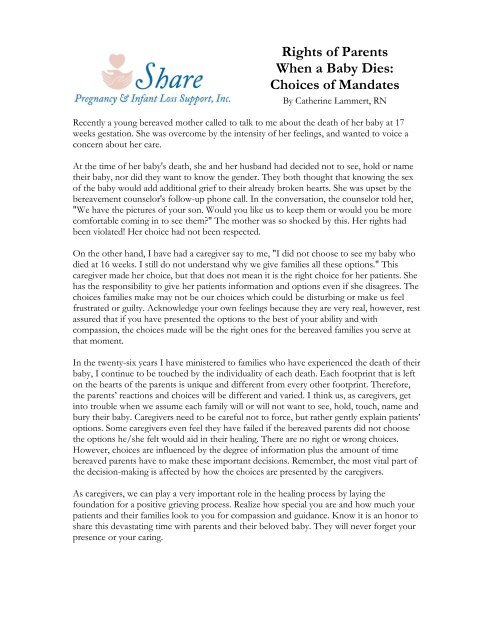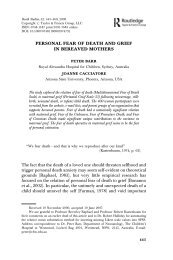Rights of Parents When a Baby Dies: Choices of Mandates - Share ...
Rights of Parents When a Baby Dies: Choices of Mandates - Share ...
Rights of Parents When a Baby Dies: Choices of Mandates - Share ...
- No tags were found...
You also want an ePaper? Increase the reach of your titles
YUMPU automatically turns print PDFs into web optimized ePapers that Google loves.
<strong>Rights</strong> <strong>of</strong> <strong>Parents</strong><br />
<strong>When</strong> a <strong>Baby</strong> <strong>Dies</strong>:<br />
<strong>Choices</strong> <strong>of</strong> <strong>Mandates</strong><br />
By Catherine Lammert, RN<br />
Recently a young bereaved mother called to talk to me about the death <strong>of</strong> her baby at 17<br />
weeks gestation. She was overcome by the intensity <strong>of</strong> her feelings, and wanted to voice a<br />
concern about her care.<br />
At the time <strong>of</strong> her baby's death, she and her husband had decided not to see, hold or name<br />
their baby, nor did they want to know the gender. They both thought that knowing the sex<br />
<strong>of</strong> the baby would add additional grief to their already broken hearts. She was upset by the<br />
bereavement counselor's follow-up phone call. In the conversation, the counselor told her,<br />
"We have the pictures <strong>of</strong> your son. Would you like us to keep them or would you be more<br />
comfortable coming in to see them" The mother was so shocked by this. Her rights had<br />
been violated! Her choice had not been respected.<br />
On the other hand, I have had a caregiver say to me, "I did not choose to see my baby who<br />
died at 16 weeks. I still do not understand why we give families all these options." This<br />
caregiver made her choice, but that does not mean it is the right choice for her patients. She<br />
has the responsibility to give her patients information and options even if she disagrees. The<br />
choices families make may not be our choices which could be disturbing or make us feel<br />
frustrated or guilty. Acknowledge your own feelings because they are very real, however, rest<br />
assured that if you have presented the options to the best <strong>of</strong> your ability and with<br />
compassion, the choices made will be the right ones for the bereaved families you serve at<br />
that moment.<br />
In the twenty-six years I have ministered to families who have experienced the death <strong>of</strong> their<br />
baby, I continue to be touched by the individuality <strong>of</strong> each death. Each footprint that is left<br />
on the hearts <strong>of</strong> the parents is unique and different from every other footprint. Therefore,<br />
the parents’ reactions and choices will be different and varied. I think us, as caregivers, get<br />
into trouble when we assume each family will or will not want to see, hold, touch, name and<br />
bury their baby. Caregivers need to be careful not to force, but rather gently explain patients’<br />
options. Some caregivers even feel they have failed if the bereaved parents did not choose<br />
the options he/she felt would aid in their healing. There are no right or wrong choices.<br />
However, choices are influenced by the degree <strong>of</strong> information plus the amount <strong>of</strong> time<br />
bereaved parents have to make these important decisions. Remember, the most vital part <strong>of</strong><br />
the decision-making is affected by how the choices are presented by the caregivers.<br />
As caregivers, we can play a very important role in the healing process by laying the<br />
foundation for a positive grieving process. Realize how special you are and how much your<br />
patients and their families look to you for compassion and guidance. Know it is an honor to<br />
share this devastating time with parents and their beloved baby. They will never forget your<br />
presence or your caring.
<strong>Rights</strong> <strong>of</strong> <strong>Parents</strong><br />
The term "rights" is not used as a mandate for the bereaved, or as a militant statement <strong>of</strong><br />
demands. It is an affirmation for parents who wish to be involved with their baby, to make<br />
decisions based on informed consent, and to assume the parenting role in meaningful ways<br />
despite the tragic circumstances. Every minute is significant, every decision important for the<br />
future peace and healing <strong>of</strong> these parents. Many, however, are afraid to request anything our<br />
society might consider morbid, unusual, or weird. This document serves as a guideline for<br />
the possibilities and options available to parents and gives them "permission" to follow their<br />
parenting instincts within the limits <strong>of</strong> state, local, and hospital policies.<br />
Before I have a conversation with the mom and dad, I acquire as much information about<br />
the patient and her significant other as possible. I read her chart and prenatal record and<br />
then talk to her primary caregivers. I also ask the patient’s caregiver if she and her support<br />
system have voiced any concerns. This better prepares me obtain answers for these worries<br />
or fears when I enter the room.<br />
I then discuss my plan <strong>of</strong> care with her primary caregivers. We use a checklist to enhance<br />
continuity <strong>of</strong> care plus an organized packet. Every staff person who cares for the patient and<br />
her family writes on this checklist and it is a permanent part <strong>of</strong> the patient’s medical record.<br />
The <strong>Share</strong> packet includes information and resources for the patient plus the necessary<br />
forms and paperwork for the caregiver. We also refer to the St. Joseph Health Center <strong>Share</strong><br />
Manual that has been compiled to assist caregivers involved in caring for a hurting family.<br />
Before I walk into the room to begin presenting the options, I say a silent prayer. This just<br />
helps me to become focused and allows me to be present to each family and their needs. I<br />
introduce myself and explain my role <strong>of</strong> caregiver to the each <strong>of</strong> them. I express my<br />
sympathy by saying, "My heart goes out to you at this time." I am a ‘touchy-feely’ person and<br />
many times, I will touch their hand or arm. However, sometimes I will sense they are not<br />
comfortable with touching, so I refrain from doing so in that instance. I then sit down in a<br />
chair close to the patient and ask if they would like to share their story with me or I have<br />
even asked, "Would you like to tell me what your baby has meant to you" As the parents<br />
share their story, I <strong>of</strong>ten discover some very important details that help me to understand<br />
what the loss may mean to this mom/couple and their support system.<br />
Before proceeding, I ask if they have any questions or concerns. Sometimes this allows for a<br />
natural lead into the options; other times there are no questions and I begin as gently as<br />
possible.<br />
1. To be given the opportunity to see, hold, touch and bathe their baby at any<br />
time before and/or after death within reason. Instead <strong>of</strong> directly asking if they<br />
would like to see and hold their baby, I ask, "Can you share with me your feelings<br />
about seeing the baby" Many times fears about the appearance <strong>of</strong> the baby will arise.<br />
I address their fears as honestly as possible. I let them know if this is a worry, a nurse<br />
or I will prepare them for possibilities, i.e., skin tears, skin discoloration. I do let<br />
them know, as with all babies, they will see special family features <strong>of</strong> each <strong>of</strong> them. I<br />
let them know they can hold the baby or put the baby in our special basket.<br />
Reassurance is given that this decision can be made during or after the birth and they<br />
can have as much time as they need.
2. To have photographs <strong>of</strong> their baby taken. As caregivers, we know the time at the<br />
hospital or funeral home is the only opportunity to take pictures <strong>of</strong> the baby. If<br />
photography is not culturally accepted, I still ask to be clear that this is not an option.<br />
For other families, I ask, “How does it feel if we take pictures <strong>of</strong> the baby” For<br />
some this may feel morbid and others are unsure. I do feel it is important to state<br />
you have a facility policy <strong>of</strong> taking some photographs. No one should be forced to<br />
take or to view the pictures, but they should be kept in a safe place for the parent<br />
should they ever want to see or have them. I explain the process <strong>of</strong> taking these<br />
special pictures, which include positioning the baby, special props and clothing. It is<br />
important to take digital photos or 35mm pictures, and pr<strong>of</strong>essional pictures. Most<br />
facilities have pr<strong>of</strong>essional photography companies that provide well baby and also<br />
bereavement pictures. In addition, local communities may have trained volunteer<br />
bereavement photographers that provide beautiful pictures free <strong>of</strong> charge. Some<br />
families choose to take an active role and use their own camera, as well as<br />
videotaping. Some may also wish to have family pictures taken. Others may be<br />
uncomfortable and refuse to have any additional pictures taken and this should be<br />
accepted and not forced on the parents.<br />
3. To be given as many mementos as possible. I explain that families have<br />
requested we give them mementos <strong>of</strong> their babies. I let them know we have a baby<br />
book available and items like a crib card, baby beads, photos, lock <strong>of</strong> hair, permanent<br />
foot and hand prints, and records <strong>of</strong> weight and length. <strong>Parents</strong> have found great<br />
comfort picking out an outfit that the hospital provides or using one they have<br />
brought from home. Any item the baby’s skin touched means a great deal to the<br />
parent – such as a blanket or a prop from the picture. These items are all tangible<br />
evidence that the baby existed and it has been found that these items aid in the<br />
parents’ healing. Sometimes the mementos may be overwhelming and the family may<br />
decide they do not want them. If this is their choice, the mementos need to be kept<br />
in a secure place like the pictures. Often the family may want them at a later date.<br />
4. To name their child and bond with him or her. Instead <strong>of</strong> directly saying, "Are<br />
you going to name this baby” I gently ask, "Can you share with me the names you<br />
picked out during the pregnancy” I ask the meaning <strong>of</strong> the names and how that<br />
decision came to be. This allows a very special conversation about this process and<br />
their connection to the baby. Then I ask if they would like to use one <strong>of</strong> their chosen<br />
names. Sometimes parents are very comfortable using the name they had originally<br />
chosen or in other instances, they may need to explore another name. If they had not<br />
picked out a name I ask if they feel comfortable naming the baby. Many times, I hear<br />
an immediate "Yes" that the baby will be named. Other times, they may say no or<br />
exhibit some uncertainty about this option. I let them know there is no pressure to<br />
name the baby. No one should be forced to make this decision quickly. Oftentimes,<br />
families may want to look at the baby or feel they need to ponder this option. Some<br />
may feel the need to peruse the many popular baby name books. There are some<br />
parents who leave the hospital without naming their baby and name their baby<br />
months and even years later. However, as soon as a name is chosen, I begin to honor<br />
the baby by using his/her name in our conversation. Another way to honor the baby<br />
is to provide a naming ceremony, blessing or baptism if the family desires.<br />
5. To observe cultural and religious practices. <strong>When</strong> I was a new OB nurse, I was<br />
always concerned that I was not completely aware <strong>of</strong> each culture and religion and
their beliefs. As years passed, I attempted to educate myself by reading and attending<br />
workshops. I gleaned valuable insights through this process. I am now more aware<br />
<strong>of</strong> different beliefs, but have found that even individuals in the same faith or culture<br />
may have very different ideas. Therefore when ministering to parents, I ask them to<br />
share their individual beliefs, past traditions and rituals regarding each choice with<br />
me. In the case <strong>of</strong> mixed faith relationships, an attempt is made to find a middle<br />
ground. Sometimes their minister, rabbi or priest may perform rituals. Sometimes<br />
they may not have a religious background or have an established religious<br />
community. The hospital chaplain can provide support and rituals as well.<br />
6. To be cared for by an empathetic staff. Many <strong>of</strong> the parents who contact me<br />
share that their healing was made easier through the sensitive caring individuals who<br />
assisted them during their darkest hours. It is imperative we continue to provide ongoing<br />
education regarding perinatal loss to our staffs via workshops, videos, etc.<br />
Recent cuts in funding for education and time constraints have made this<br />
opportunity challenging. Many perinatal organizations now provide online courses<br />
and pr<strong>of</strong>essional support.<br />
7. To be with each other. With today's family-centered OB units, hopefully, it is a<br />
given that one's support system will be allowed to stay with the mother twenty four<br />
hours a day, plus be near during all procedures. This policy should include the father<br />
or partner <strong>of</strong> the mother and in the case <strong>of</strong> a single mom, her support person as well.<br />
8. To be given time alone with the baby. After parents have had some time with the<br />
baby in my presence, I ask them if they would like time alone with their baby.<br />
Provide them with a bassinet or basket for the baby, items for bathing the baby,<br />
extra baby clothing, a rocking chair, CD player, soothing music and a camera. I let<br />
them know where I will be and that they can turn on the call light if they need me. I<br />
assure them that this is their time and we will not intrude. Sometimes after the baby<br />
has been taken to the morgue, additional request(s) may be made later to see the<br />
baby again. This request is honored. The baby is brought back up to the nursing<br />
division, warmed on the baby warmer or placed in a warm blanket so parents can<br />
have additional time with their baby.<br />
9. To be informed <strong>of</strong> the grieving process. Many times parents are unable to process<br />
all the information we give them initially due to their feelings <strong>of</strong> shock. This may be<br />
the first time they have experienced a tragedy and they may be overwhelmed by the<br />
intensity <strong>of</strong> the many feelings <strong>of</strong> grief. It may be challenging for them to read a large<br />
publication so small vignettes or brochures that explain the grief process are easier<br />
for them to read and digest and should be included in their take-home packet. In<br />
addition, the mourning needs <strong>of</strong> siblings, grandparents and other family members<br />
should also be addressed and acknowledged with appropriate resources made<br />
available for these needs.<br />
10. To be given the option <strong>of</strong> donating their baby’s cartilage, tissue and/organs<br />
for transplant or donating the baby’s body to science. In general, attention has<br />
been brought to the forefront about tissue and organ donation. This opportunity can<br />
only occur if a baby is <strong>of</strong> designated gestation and/or a live birth. Laws have been<br />
passed to explore these donor options after death. Facilities have trained organ<br />
donor representatives who have printed materials and the knowledge to explore
these options. If the family has an interest in donating the baby’s body to science,<br />
some research would need to done at a local medical university to see if this is a<br />
possibility.<br />
11. To request an autopsy or pathology exam and genetic testing. Often the<br />
parents are frightened by the prospect <strong>of</strong> any testing or they are not clear about the<br />
need or reason for an autopsy or pathology exam. It is vital that their physician/s<br />
discuss these options and the possible reasoning and/or benefits for these<br />
procedures. Another concern is the cost involved in the testing. I ask them if they<br />
want to me to explain the procedures. Their fears and concerns <strong>of</strong> each option are<br />
discussed. Some do not want their baby to be subjected to any additional procedures<br />
and others feel it is important to explore all possible avenues for answers. If<br />
possible, it is important to delay the autopsy until the family has spent time with the<br />
baby. However, the baby can still be seen by the family after the autopsy at the<br />
hospital. Usually, final results <strong>of</strong> an autopsy or genetic testing make take 6-8 weeks<br />
for the report.<br />
12. To have information presented in understandable terminology. Everyone has<br />
the right to comprehend the material presented to him or her. It is imperative to<br />
speak in terms that parents will understand. Also, due to their state <strong>of</strong> mind, they<br />
may need to have the information repeated more than once. It is also important to<br />
have an interpreter for non-English speaking persons or someone to sign for a deaf<br />
person.<br />
13. To plan a farewell ritual, burial or cremation. Instead <strong>of</strong> asking the family, "Are<br />
you going to have a funeral" I ask, "Can you share with me your feelings regarding<br />
having a funeral or a ritual" With this question, you <strong>of</strong>ten find out their past<br />
experiences, faith background or spiritual needs in regards to death. I acknowledge<br />
how difficult planning a funeral might be for them since this could be the first time<br />
young parents may be attending the funeral <strong>of</strong> someone in their immediate family, let<br />
alone planning one. I let them know we will help them in addition to their clergy (if<br />
there is someone) or funeral director. If they do not have a religious affiliation you<br />
may be their main resource. I share with them that the ceremony can be as personal<br />
as they choose. We address their cultural and religious traditions in regards to the<br />
rituals. I also give them printed information regarding area funeral homes/cemeteries<br />
with options and costs. I have assisted many families through this challenging choice<br />
and I am always amazed at the individuality <strong>of</strong> each farewell ritual. It is vital as<br />
caregivers that we are aware <strong>of</strong> state and local regulations regarding burial. If their<br />
wishes are within regulations, they should be honored.<br />
14. To receive information on support resources. A list <strong>of</strong> support resources should<br />
be given at the time <strong>of</strong> discharge. A follow-up phone call may need to be made<br />
before the farewell ritual to assist them with final decision making. Additional calls or<br />
emails should be made to check on the family at established intervals and at difficult<br />
times, i.e., due date, anniversary. If a support group is run by the institution, followup<br />
letters explaining the meeting and upcoming meeting dates and memorial services<br />
should be sent by the facilitator. In addition, the availability <strong>of</strong> other resources such<br />
as interactive perinatal loss websites, library books and videos or newsletters should<br />
be noted.
<strong>Rights</strong> <strong>of</strong> the <strong>Baby</strong><br />
1. To be recognized. It is important to explore what this pregnancy meant to the<br />
family. The bonding process may begin very soon in the pregnancy; therefore, hopes<br />
and dreams for this baby may have already begun. If the family considers this<br />
pregnancy as a human being, this needs to be respected. Avoid insensitive<br />
terminology such as the “missed abortion,” “fetal tissue” or “products <strong>of</strong><br />
conception.” Acknowledge the baby's presence by a birth or recognition <strong>of</strong> life<br />
certificate. Always use the baby's name when referring to the baby.<br />
2. To be named. Explore the patient's and her partner's feelings regarding naming the<br />
baby. This may be too overwhelming and they may choose not to name the baby.<br />
This needs to be respected. If they are indecisive, let them know there are no time<br />
limits. Others have named their baby weeks, months and even years later.<br />
3. To be seen, touched and held. In respect to the baby, he/she should be presented<br />
in a s<strong>of</strong>t blanket and beautiful clothes as you would a live baby. <strong>When</strong> families see us<br />
respect and cuddle the baby, they may find it easier to do so themselves. If the<br />
parents choose to not see, hold or touch the baby, this should be respected.<br />
However, they may be grateful if you held their baby even if they could not.<br />
4. To have life ending acknowledged. A farewell ritual may be very helpful in<br />
acknowledging the short time this baby was here. Give parents information on the<br />
different styles <strong>of</strong> birth and death announcements available. Explain the many<br />
creative ways <strong>of</strong> memorializing their baby, from memory books and boxes, to tree<br />
plantings. Holiday memorial services and remembrance walks honor these precious<br />
babies in the years to come.<br />
5. To be put to rest with dignity. Burial or cremation options should be explained to<br />
all families regardless <strong>of</strong> gestation <strong>of</strong> pregnancy. All states have strict regulations for<br />
proper disposition <strong>of</strong> babies over twenty weeks gestation in which a baby must be<br />
buried or cremated. There are no regulations for babies that are delivered or<br />
miscarried prior to twenty weeks gestation thus the remains are considered medically<br />
waste. However, some facilities have established policies and have collaborated with<br />
funeral homes and cemeteries respectfully caring for the remains <strong>of</strong> babies under<br />
twenty weeks gestation at a quarterly group burial. Some states have laws that insist<br />
that the patient experiencing early loss be informed <strong>of</strong> the hospital disposition policy<br />
and also are given the right <strong>of</strong> private disposition. If there is a hospital disposition<br />
option, a minimum thirty day waiting period for burial/cremation allows families to<br />
reconsider their decisions. Invitations should be extended to families to attend the<br />
group burial or memorial service. The parents have the right to know where their<br />
baby is buried. A memorial headstone at the group burial site is comforting. Burial<br />
cradles for tiny babies less than twenty weeks are available for a dignified burial.
The <strong>Rights</strong> <strong>of</strong> <strong>Parents</strong> and Babies were originally revised and enhanced by Sr. Jane Marie Lamb, OSF and<br />
Foundress <strong>of</strong> <strong>Share</strong>, from a document developed by the Perinatal Bereavement Team at Women's College in<br />
Toronto, Canada. The <strong>Rights</strong> were updated in 2008 by the National <strong>Share</strong> Office Staff. The <strong>Rights</strong> <strong>of</strong> the<br />
<strong>Parents</strong> and the baby can be used as guidelines for institutions and as a handout for parents.<br />
References<br />
* <strong>Parents</strong>’ Needs and <strong>Rights</strong> <strong>When</strong> a <strong>Baby</strong> <strong>Dies</strong>, Sr. Jane Marie Lamb, OSF Health Progress, December 1992.<br />
** Videos: Footprints on Our Hearts and At a Loss for Words, Paraclete Press (no longer available)<br />
*** Bittersweet…hellogoodbye Edited by Sr. Jane Marie Lamb, OSF is available through the National <strong>Share</strong><br />
Office 1-800-821-6819.<br />
Original February 8, 2001, Caring Notes, <strong>Share</strong> Pregnancy and Infant Loss Support, Inc. pr<strong>of</strong>essional<br />
newsletter revised November, 2009















